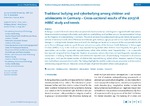Traditional bullying and cyberbullying among children and adolescents in Germany – Cross-sectional results of the 2017/18 HBSC study and trends
Fischer, Saskia M.
John, Nancy
Melzer, Wolfgang
Kaman, Anne
Winter, Kristina
Bilz, Ludwig
Bullying is a specific form of violence that can potentially lead to numerous and long-term negative health implications.
Despite consistent coverage in the media, particularly on cyberbullying, as of yet there are only few representative findings
on the frequency of (cyber)bullying in Germany. This article analyses how widespread bullying and cyberbullying were at
schools in Germany in 2018, what differences exist between girls and boys, age groups and various types of schools, and
changes in bullying trends between 2002 and 2018. Our findings are based on an analysis of the data provided by the
2017/18 cycle (N=4,347 students, 53.0% female) and previous cycles of the German Health Behaviour in School-aged
Children (HBSC) study. In the 2018 cycle, boys reported having bullied other children more frequently than girls, but
were bullied just as often. 15-year-olds reported having bullied other children more frequently than 11- to- 13-year-olds
but reported being bullied less frequently. Students at grammar schools (Gymnasium) least frequently reported any
involvement in bullying. Only few children and adolescents reported cases of cyberbullying. Compared to all previous
survey years, 2018 saw the lowest number of children that reported having bullied others. However, reports of having
been bullied have remained almost stable. The findings highlight the need for evidence-based prevention and intervention
anti-bullying programmes and measures across all types of general education schools and age groups.
Dateien zu dieser Publikation
Keine Lizenzangabe

